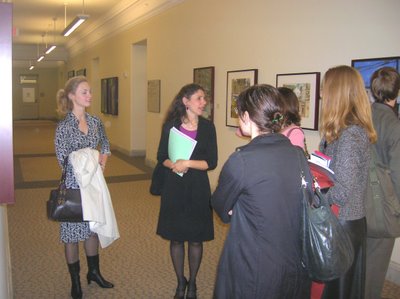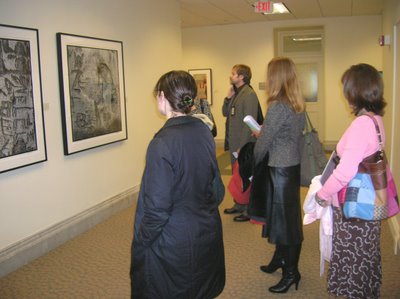City Hall Art Collection Walkthrough
A few days ago I had the opportunity to walk through the new Washington, DC City Hall Art Collection at the Wilson Building.
Together with Jonathan Binstock and Sarah Newman (both curators at the Corcoran), and Kristen Hileman and Anne Ellegood (both curators at the Hirshhorn), and Kim Ward (Executive Director of the WPA/C), we were given a personal tour of the collection by its curator, Sondra Arkin.
I had never been to the Wilson Building before, and I must admit that I have probably walked or driven by it a dozen times in the past without being aware that this is the place where the District's business as a city take place. The building is very beautiful and recently renovated, and the insides incorporate and marry the building original neo-classical appeal with a modern sense of stainless steel and minimalist design in places.
After passing through the excellent security check-in at the front entrance (ID required), Sondra gave us all a copy of the superb catalog that she was able to create in about six weeks.
The Hirshhorn curators and I were astonished that Arkin was able to pull off such a quality catalog, plus do a huge number of studio visits, plus curate the exhibition, and organize the framing, in a handful of weeks.

Arkin begins tour
I am always complaining that DC area museum curators seldom pay attention to district artists, and I think that the major contribution that this collection offers is a central point for them and visitors to see the vast array of talent that our capital area has to offer.
One exception and a DC area artist who needs little introduction to curators is the ubiquitous and hard-working Maggie Michael, and one of the first works that we were taken to was "Phantom," a large painting by Michael on the first floor.

I must admit that as we approached the painting I thought that it was a piece by Trawick Prize winner Jiha Moon and said so, which brought some quizzical looks directed at me from the fair Anne Ellegood. But I stuck to my guns and noted that the painting seems to borrow heavily from Moon's visual ideas, and the "center" of it appears to be a Jiha Moon on top of a Maggie Michael painting.

Curators Looking at Prescott Moore Lassman's photographs
Another artist whose work caught some good detailed attention were the photographs by Prescott Moore Lassman, which when associated with the story behind them (the subject were the people in one of the first integrated churches in the nation), seemed to merit some extra time from them. Prescott's skills with the camera to capture the essence and depth of a moment, while making the image burst with attention-grabbing intrigue, is what makes his work special.
The Hirshhorn curators both seemed to like "In Red," a beautiful canvas of Tom Green's invented symbols, which also appealed to me based on my interest in "text" in art. As such I had to take the opportunity to taken them to Mark Cameron Boyd's "No Way to Convey," and explain Mark's fascinating process to create art out of textual references.
Somewhere along the tour, we discovered Judy Jashinsky's 1980s vintage portrait of Corcoran photography curator Philip Brookman, and Binstock, Ward and Newman had a bit of good fun enjoying their fellow curator's portrait. "He still has that watch!" someone said.

Philip Brookman by Judy Jashinsky

Jonathan Binstock records the Brookman
The representational holdings in the collection, as usual, brought out interesting stories about them, and the reaction to them from the building's occupants. The ability of a representational work to clearly convey an idea or suggestion immediately makes its selection for a public art display a very difficult process - at least in the United States.
One artist who must have been very hard for Arkin (no pun intended) to select is the talented Joe Shannon, who regularly appeals in his own paintings, not only nude, but also often sporting a massive erection. But not the piece in this collection, "Two Poets with Champion," in which Joe does sneak in a shirtless male.
The physical attributes of the space itself, and the occupants themselves, also played an important role in Arkin's selection and placement process, as some of the city fathers and mothers "own" certain halls (where their offices are) and were part of the process for what "hung" there.
Tucked away in the furthest corner of one such hall is Michal Hunter's "The Fountain," a overtly sensual 1981 painting by one of Washington's top realists. There is no nudity in this work of two women enjoying the sun and refreshing themselves in a public fountain. But there's plenty of implied sensuality and Eros in this work, which may be the sexiest public art piece in the nation's capital.
The DC glass gods are also well represented in this collection (although so far ignored by DC area museums and curators, while at the same time being picked up by other American museums), with two mixed media pieces by Tim Tate and Michael Janis.
Photography is an important part in the collection, with the usual suspects represented by a mix of well-known work or new images. Works by top photographers such as William Christenberry, Maxwell MacKenzie, and Chan Chao are complemented by newly emerging camerartists such as Alexandra Silverthorne, Prescott Moore Lassman, Holly Foss and others.

Curators looking at Maxwell MacKenzie's new work
The collection is also well stocked with some of the District's top names from the "old school", such as Gene Davis, Jacob Kainen and Felrath Hines, while active well-known names such as John Winslow, Sam Gilliam, Michael Clark, Robin Rose, James Huckenpahler and others are also augmented by very good works by Pat Goslee, Jiha Moon, Lisa Montag Brotman, Anil Revri, Michele Banks and Andrew Wodzianski.
Not all is perfect. While looking at Kainen's two rather forgettable etchings in the collection (Blue Cocoon and Dr. Mabuse), I made the comment that I wasn't a big Jacob Kainen fan, which brought out an alarmed look and immediate response from Jonathan Binstock. We discussed the issue, and while I certainly admire Kainen's amazing work ethic and his persistence in making an art footprint in the District (which he did), I have never been particularly attracted to his work, although I will allow that a DC collection without a Kainen is missing a key component, so I am glad that he's represented here.
Talking about "missing," there are some notable missing names from this collection, such as Maggie Michael's talented husband (Dan Steinhilber), some Color School guys like Morris Louis (completely unaffordable at this point, so a donation would be nice), Margarida Kendall (same issue), Annie Truitt (same problem), Manon Cleary, Erik Sandberg, Molly Springfield, Kelly Towles, Mark Jenkins, Colby Caldwell, Kathryn Cornelius, etc.
Finally, I've been getting some emails complaining about the scarcity of sculpture in the collection. This is always an issue in "indoor" public art, as a large range of sculpture does not adapt well to being exposed and inside public buildings. But I think that Arkin did an excellent job of acquiring a good set of three dimensional works, such as the previously mentioned works by Tim Tate and Michael Janis, plus excellent pieces by Margaret Boozer, Marie Ringwald, Jae Ko, Andrea Haffner and F.L. Wall. Well-known sculptor Yuriko Yamaguchi is represented by an interesting litho.
I think that I know district area artists as well as anybody, and yet even I "discovered" some new artists who have excellent work in this collection. One such artist is printmaker Alexandra Huttinger, whose series of small linoleum prints not only capture a visual record of people, but also push the limits of that difficult medium. Brenda Hoffman's photographs also caught my attention (and that of a couple of the curators).
In spite of Sondra Arkin's spectacular effort, there are still plenty of empty walls left in this building, and it is my hope that the District of Columbia Commission on the Arts and Humanities will expand on this $400,000 investment and continue, on a regular basis, to grow the collection, and to add to it on a yearly basis, so as to truly make it into an almost Washington Art Museum.


